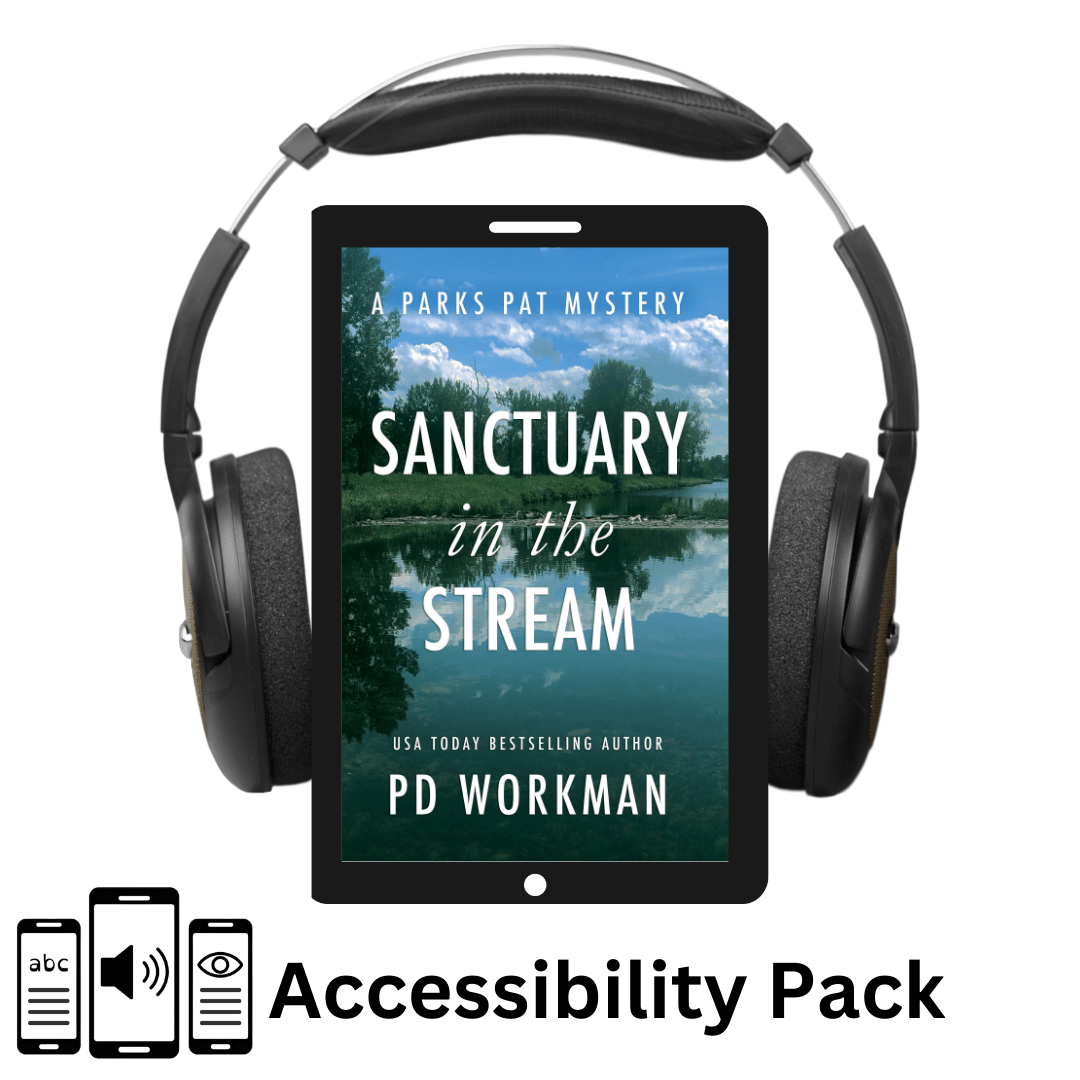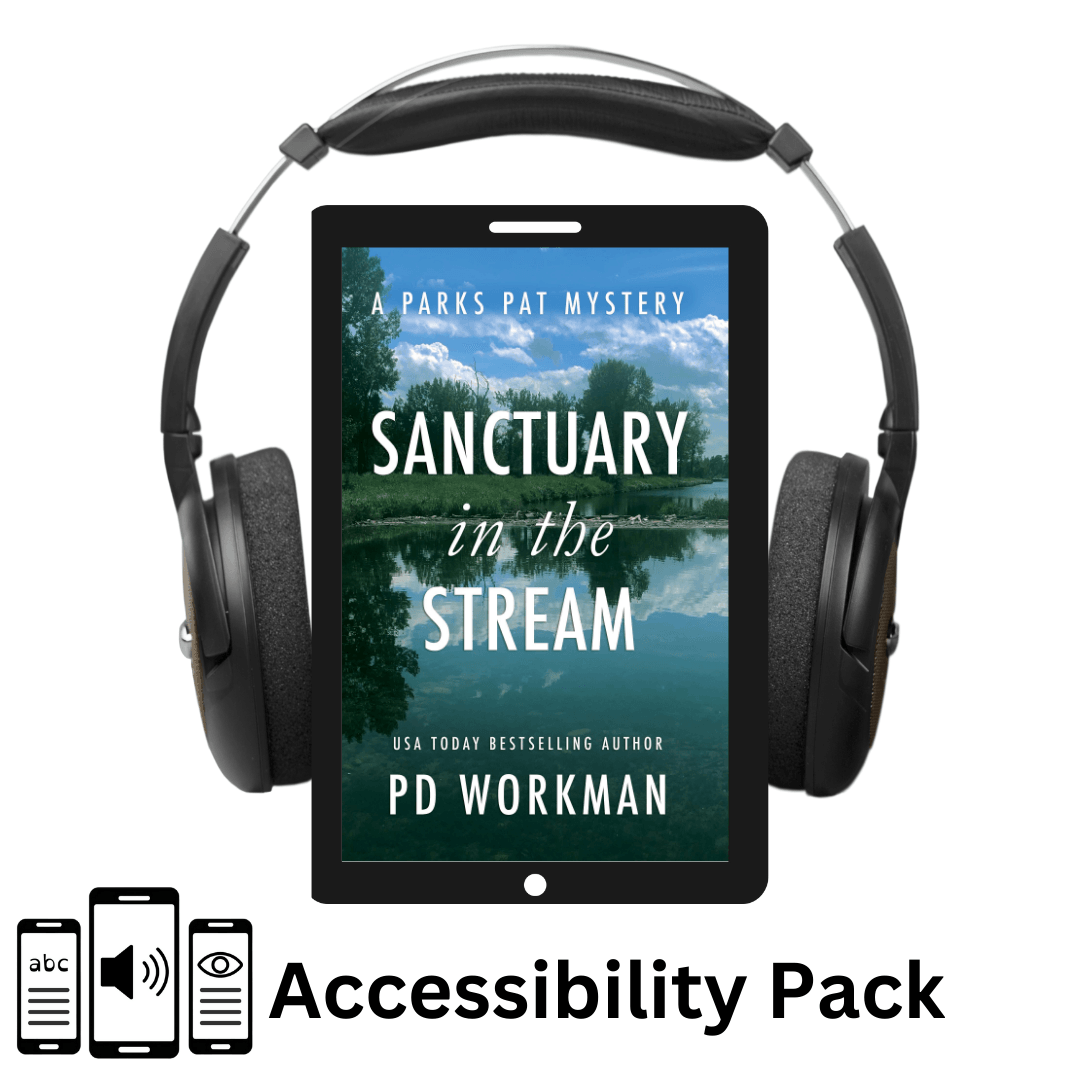Sanctuary in the Stream - PP 9 accessibility pack
Sanctuary in the Stream - PP 9 accessibility pack
Couldn't load pickup availability
A dam violent scene
Detective “Parks Pat” Patenaude is called to an idyllic scene in the Inglewood Bird Sanctuary. Where the scene is marred only by the body of a man who apparently got in the way of beaver construction.
Nature can be cruel and beavers have been known to attack. This national symbol can be rabid and vicious.
Yet that does not appear to be the case this time, and Parks Pat is on the case, hoping to uncover the truth in this unexpected death.
⭐️⭐️⭐️⭐️⭐️ P.D. Workman is an incredibly versatile writer. No matter which of her books I read I am drawn into a great story and honestly, I don’t think I’ve followed another author that could go from cozy mystery to YA to a PI series dealing with mental health issues. Really enjoy her books!
Looking for a police procedural set in picturesque Canada? Let Award-winning and Bestselling Author P.D. Workman take you to her favourite Calgary parks, as Métis detective Margie Patenaude investigates a murder in this fast-paced new series.
These short mysteries are just right for those days when you could use a break from your busy life. Take a walk in a Calgary park with Parks Pat.
Jump into in a new mystery today!
Returns
Returns
All sales are final.
If you have accidentally purchased the same ebook twice, please contact me and we will work it out with a refund or store credit.
Share

Accessibility Packs
Accessibility Packs are not yet available for every book.
If available, an Accessibility Pack contains three files:
- An eBook copy
- A pdf copy in OpenDyslexia font with other accessibility features
- An autonarrated (text to speech) audiobook in mp3 format
ACCESSIBILITY FEATURES OF EBOOK (VARIES BY DEVICE):
- Choose your typeface
- Change the font size
- Set your line spacing
- Light, dark, or sepia themes
ACCESSIBILITY FEATURES OF PDF
- OpenDyslexic font is designed to be more readable for those with dyslexia
- Rag right—not fully justified—to eliminate gaps between words
- Paragraphs not indented, separated by extra space
- No hyphenation
AUTO-NARRATED AUDIOBOOKS
Audiobooks allow readers to listen to a book rather than or simultaneously with reading the eBook or PDF file. They are also helpful if you are someone who needs to move around while learning.
Standard audiobooks are expensive to produce. There is nothing like a voice actor narrating a book. He can add nuance and humour and many other benefits to the audiobook. I still want to produce more human narrated audiobooks. However, in order to bring more of my catalog to you in audio form, I have used text-to-speech, computer-narration technology. This allows me to reach more readers who need assistance with reading. While auto-narration is improving, these audiobooks do sound robotic and do not contain the nuance of human voice narration. Some readers will find this too distracting, but for others, it is just the tool they need to help them enjoy more books.
Collapsible content
Click to Read Sample
CHAPTER 1
Margie rolled over, fighting her way through the fog of sleep. It was dark out, so she should still be able to sleep, but her phone was ringing, and she couldn’t ignore it. She wasn’t on standby, but sometimes they called her even if someone else was on the list. She squinted, trying to get her eyes open, and reached out to her side table, feeling for the phone that was flashing, vibrating, and ringing.
If it was a wrong number, she was going to be really ticked off.
Her fingers wrapped around the phone, and she turned it around and brought it up to her face to read the name on the caller ID. It was the dispatcher. Margie sighed.
Not a wrong number.
She wished it had been.
“Hello?”
“Detective Parks Pat,” the dispatcher greeted cheerfully, using Margie’s nickname. Which was probably a hint about why she was getting a call. Another murder in a park. It was surprising how often she was called for her area of “expertise.”
Really, she didn’t have any more expertise than any other homicide cop in Calgary in the area of homicides in parks and green spaces. She just had the luck to have been branded as Parks Pat after a couple of similar cases, the detective who would thereafter be called to each and every murder in a Calgary Park.
“I’m here,” Margie said. “Where is it?”
“Inglewood Bird Sanctuary.”
“Inglewood.” Margie knew where Inglewood was, just down the hill and across the river from where she lived with Christina. She shouldn’t get lost on her way to this one.
“You ever been there?” the dispatcher asked.
“No. Should have been.” Margie wiped her eyes. She sat up and tried to blink herself awake. “It’s close enough. But it’s been quite the year.”
“Yes, it has,” the woman agreed. “Do you need geographic coordinates?”
“Please.”
“I’ll send them to your phone.”
“What am I going to find out there?”
“Man deceased during the night. Signs of violence. Found by an early morning walker.”
Margie looked at the window. “What time is it?”
“Five-thirty.”
Margie groaned. “How can people get up that early? And how do they find a body in the dark? Can’t they wait until it’s light out?”
“Sorry about that.”
“Yeah. Medical Examiner’s office?”
“I’ll be calling them next. But they had another call an hour ago, so it might be a couple of hours before they get out there.”
And in the meantime, Margie would need to babysit the crime scene. She needed to make herself a coffee first. Something to keep her warm. And maybe put some of those HotShots in her shoes and gloves too. Though Calgary was experiencing a very mild autumn, Margie knew from experience that standing around when the temperature was just a few degrees above freezing could get uncomfortable very quickly. A temperature that was comfortable while running or walking was not pleasant when standing still for long periods.
Margie checked her braids after hanging up the phone. They were still tightly woven with few escaped strands, so she wound them into a bun and pinned it in place and didn’t have to worry any more about that. Bathroom, coffee, and clothes, and she could be on her way.
She scribbled a note to Christina and stuck it to the coffee maker. Her daughter had made it clear that she preferred not to be woken up whenever Margie got a call-out. It wasn’t like Christina was going to panic if she got up in the morning and her mother wasn’t there. She was a teenager and old enough to prefer sleep to saying goodbye to her mom.
Margie was pleased when the GPS told her it would take fewer than ten minutes to get to the Bird Sanctuary. It wasn’t quite true that she had never been there before. She had been once or twice as a child visiting Calgary over the summer. But she hadn’t been there since moving to Calgary the previous year and had never driven there. She followed the directions from the electronic voice on her GPS. The roads were quiet and dark. A little vehicular traffic, but not much. The GPS guided her into the parking lot in front of a small building. There were a few civilian cars parked, a couple of marked Calgary Police Service black and whites, and an ambulance.
The only person Margie saw initially was one of the paramedics, getting something out of or putting something away in one of the side panels on the ambulance. The woman turned at the sound of Margie’s footsteps.
“Hello?”
“I’m Detective Patenaude. Homicide.”
“Well, it didn’t look like a homicide to me. But they’ll fill you in. The visitor’s center isn’t open yet, so you need to go around to the side gate,” the paramedic pointed to the right side of the building.
“Great. And how far in is it?”
“Not far. Right-hand trail. There should be a cop there to guide you.”
“Okay. Paramedics declared death?”
She nodded. “No signs of life.”
Following the paramedic’s directions, Margie was able to get through the gate and followed the pathway behind the visitor’s center, across a grassy field, to a small bridge that set her heart pounding. Margie could only see black shadows in the stream bed below the bridge. She turned on her phone flashlight and shone it into the shallow ditch. It was completely dry. She took a few deep breaths and walked across the bridge. Continuing on the pathway, she reached a T intersection, where a uniformed CPS officer was keeping watch. He nodded at her. “I’m afraid the park is closed,” he advised gravely.
“Detective Patenaude. Homicide.” Margie pulled out her identification and showed him.
“To the right,” he advised and pointed. “Did you find something?”
“Sorry, what?”
“Over there,” he motioned back at the bridge. “You turned on your flashlight. Get spooked by a skunk?” he suggested.
“No. I was just looking to see if there was water or not.” Margie shrugged and didn’t explain further.
“Oh.” He nodded and threw a glance over his shoulder to the pond behind him. The left- and right-hand trails circled around the pond. As long as Margie didn’t have to cross any bridges, she was fine. She could stand being beside the water.
“How far around is it?”
“Just down this end.” He pointed to her right again. “Past the Walker House.”
Margie nodded and started off down the pathway. She could hear the wind rustling through the leaves, and a few sounds that might be birds or other animals, but it was very quiet. In a couple of minutes, she saw the tall, boxy shape of the Walker House to her right. The moon reflected in the pond on her left; little silvery ripples and the lapping of the water on the shore made it seem serene and completely harmless. But she could never trust a body of water completely. They were more dangerous than they looked.
Up ahead, she could see a small cluster of people gathered around, chatting and waiting, in the manner of all cops who had to hang around a crime scene while waiting for a detective or some other investigator to show up. They learned not to be impatient. To just stand and wait and, eventually, the needed officials would show up in their own good time.
“Hi,” Margie greeted. “Sorry to keep you waiting.”
Even though she had gotten there in ten minutes, and they had probably assumed they would have to wait for much longer. And probably would have to wait much longer if the Office of the Chief Medical Examiner was tied up at another scene. The least she could do was apologize.
“Detective Pat?” one of the cops asked.
Margie nodded. “That’s me.”
“Parks Pat?” another piped up.
“Detective Parks Pat,” Margie agreed good-naturedly.
“You’re the expert on deaths in parks?” The cop didn’t sound too convinced. Margie could understand his skepticism.
“It’s just a nickname. I’m no more or less qualified than any other homicide officer to investigate a death in a park.”
They all nodded, looking at each other. She got the feeling that the subject had been discussed before she got there, and some opinions expressed.
“So, what have we got?”
CHAPTER 2
They waited while Margie got her booties and other gear on so that she wouldn’t contaminate the crime scene, and only one of the cops crossed the yellow tape with her, leading her to the water’s edge a few meters away. His name bar informed Margie that he was Constable O’Leary.
The victim was male, fully clothed, and mostly submerged in the shallow water. Margie felt like her throat was closing up just looking at him.
“What am I seeing?” she asked, as O’Leary’s flashlight flicked around the scene too quickly for her to take anything in. He slowed down, shining on the man’s face to start with.
“Facial lacerations and contusions,” he pointed out. The victim had dark hair and a beard. O’Leary’s flashlight followed the trunk of a tree that lay across the victim’s chest, extending on either side so that the branched end was in the water and the other end, trunk chewed into a rough point like a badly sharpened pencil, lay on the ground a few feet away from them. “Beaver,” O’Leary pointed out the obvious. “Chopped down the tree, pinning him. Don’t know if it attacked him, causing the scratches, and then pinned him, or if it knocked him down with the tree and then attacked him, keeping him from being able to get up again.”
Margie shook her head, looking at it. “Why would a beaver attack him or pin him down?”
“They’re vicious creatures,” O’Leary said. “Canada’s national animal might look cute and cuddly, but they’re not. Before you came, we were looking up stories of beavers attacking. They’ve been known to kill a full-grown man.”
“Why?”
“They’re territorial and man is infringing on their territory.” He shrugged.
“There have been beavers in this park since I was a kid.” Margie looked into the darkness past where the victim lay, knowing that a long beaver dam stretched out across the water another hundred meters upstream. “Why would they attack now? And I’ve never heard of one intentionally pinning someone with a tree.”
“There was an episode of Bones where the victim was buried in the dam by a beaver,” O’Leary offered helpfully. “It didn’t kill him, but I guess it decided that his body was good enough to use in his dam.”
Margie stared at him. “That’s a TV show. That’s not real life. I’ve never heard of anything like that happening in real life.”
O’Leary considered this, head cocked to the side. “They’re usually pretty good about taking things that happened in real life to use in the episodes. So maybe there was a real Dude in the Dam.”
Margie just shook her head. “Did they call in anyone from the visitor’s center? Can they tell us whether there have been any other beaver attacks or any complaints about aggressive beavers?”
“I don’t think they’ve called anybody. We don’t have a contact person. The website just has general contact numbers on it. An after-hours recorded message. We won’t be able to contact anyone until someone actually gets here.”
“Well, that’s helpful.” Margie sighed.
She heard a splash in the water. O’Leary played the flashlight over the surface of the water closest to them, but there was no sign of whatever had just broken the surface. Margie shifted anxiously.
“It’s still out there. Whatever attacked this man. And I don’t have a clue how many there are. It will be at least a family unit. There’s always been beavers here, so there could be dozens. And they can all see us better than we can see them.”
O’Leary shone the light around on the shore, looking for any sign of the wobbling gait of a beaver moving through the trees. “I wasn’t freaked out before you got here. Thank you very much for that.”
Margie shrugged. “I think we should all stay together as a group. Less likely to be attacked that way.”
“We’re not going to get attacked,” O’Leary insisted, but she noticed that he moved more quickly than she did to rejoin the others. They crossed the tape, which, even though it was a flimsy artificial barrier, made Margie feel like she was “home safe” and the beavers wouldn’t attack her there. Not while she was with so many other people.
The others were looking amused. Maybe because they hadn’t been separated from the group, they hadn’t felt the anxiety of being in the dark with a wild animal, however silly it seemed. Still, that man was dead and a beaver had been involved somehow.
“Do beavers get rabies?” Margie asked the others.
They all looked at each other.
“I don’t know,” one of them said, the sharpness in his tone reflecting Margie’s own nervousness.
Rabid animals were unpredictable. Other mammals could get rabies—dogs and skunks and raccoons—so she assumed that all mammals could. That would include rodents like beavers. Who knew how rabid beavers would behave? They wouldn’t need to be triggered by humans getting too close to their dam or lodge or their young. They wouldn’t have to be territorial. They could “go off” and attack for no reason. Margie didn’t feel like having to go through a rabies protocol. It was easier than it used to be, but she knew it still involved more than one needle.
“Do we have an identity on the victim yet?” Margie asked.
O’Leary shook his head. He looked relieved to be discussing something other than dangerous beavers. “No one was going to go through his pockets while he was still in the water, and we need to leave him there until the medical examiner’s office gets here. We know he’s dead. There are no lifesaving measures to perform. So we’ll just have to wait until they get here and either check his wallet or find some way to identify him.”
“Have you checked for missing person reports?”
“Not yet. That sounds like a detective job.”
“So it is,” Margie agreed. She pulled out her phone and tried a few numbers before she managed to get someone at a computer who could do a search for her. There was no guarantee that the man would have been reported missing yet. He was recently deceased, or his body wouldn’t look so good. It could be that no one had missed him yet. She described him the best she could, based on the quick look she’d gotten of him by the light of O’Leary’s flashlight. She wasn’t walking back over there alone to get a better description.
“There is a recent missing who matches your description,” the Officer of the Day told Margie. “A Tristan Elliott. Missing from… your area of the city.”
“Where, exactly?”
“Inglewood.” The woman gave Margie an address, which she jotted down in her notepad while squeezing the phone to her ear with her shoulder.
“Great, is there a phone number? And the name of the person who reported him?”
“Reporter was… Pete Ramsey.” She gave Margie the phone number.
“Any details there? Their relationship? Where Tristan was seen last?”
“Looks like they are housemates. Same address. Last seen at the residence, but Tristan went for a walk and never returned.”
“And that’s not like him.”
“Apparently not. Nothing on file for him. No previous missing report, no convictions, no alerts.”
“Okay. We may have him, but I’ll wait for some kind of verification before we notify Ramsey. Medical examiner hasn’t been here yet. Do you have a picture of Tristan?”
“I do. Can I text it to this number?”
“Yes, that would be great. Appreciate it.”
She disconnected and filled in the officers standing around, leaning toward her to catch as much as possible from the phone conversation.
“There’s a recent missing who matches the description. Went for a walk in Inglewood and didn’t return.”
“That’s gotta be him,” O’Leary said with assurance.
Margie nodded. “Most likely. But we’ll wait for verification. I’ve seen what can happen when someone spills the beans too soon and it’s a misidentification. It’s not pretty.”
Heads shook as they pictured it or imagined it happening to them. How would they feel if someone told them their loved one was dead and it turned out not to be true? Even though grief and anger eventually turned into relief, it was not pleasant to be on the receiving end before it worked itself out. And did people trust the police after something like that? They would probably never believe anything a law enforcement officer said again.
Award-winning Canadian author P.D. Workman has written over a hundred addictive page-turners featuring diverse and divergent sleuths, high-stakes investigations, and stories that linger long after the last page.
Her books dive deep into characters’ minds while exploring timely social issues through fast-paced, emotionally charged plots. Readers praise her work for its powerful emotional truth combined with unputdownable suspense.




